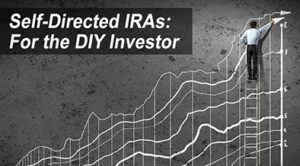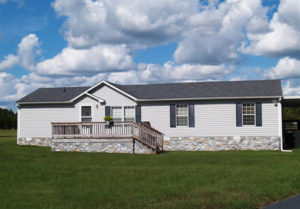 With a little time to go before tax day, you’ve still got time to fully fund – up to $5,500 or $6,500 if you’re at least 50 years old – your Individual Retirement Account (IRA). As a certain former Governor of California used to say in the movies: Do it.
With a little time to go before tax day, you’ve still got time to fully fund – up to $5,500 or $6,500 if you’re at least 50 years old – your Individual Retirement Account (IRA). As a certain former Governor of California used to say in the movies: Do it.
Today’s lesson is a departure from the solid, sensible, (maybe boring?) advice I’d usually give you regarding IRAs, and instead is about a do-it-yourself (DIY) version of IRAs that you should know about. But you shouldn’t necessarily “do it.”
But first, the boring, correct thing you should do with your retirement money: Set up automatic regular contributions to a low-cost (probably indexed) 100 percent stock fund at a brokerage house, and never, ever, sell. Also, be sure to do this starting at age 22. That’s how you guarantee your wealthy retirement.
While most of my retirement money is sensibly invested as described above, a portion of my retirement money is in a self-directed IRA. What does that mean? That means I like to make things difficult for myself. For some good reasons, and some bad reasons, which I’ll explain.
 A self-directed IRA greatly expands the category of things you can purchase into your IRA. With a self-directed IRA, You can buy real estate, like raw land, a commercial building, or even a house. (You can’t live in a house owned by your IRA, however, that’s a clear No-no.) With a self-directed IRA you can invest directly in a hedge fund, a venture capital fund, or simply shares in a privately-held business or limited partnership. (Although you can’t own a business that also pays you a salary, that’s also a clear No-no.) You can even buy physical commodities like gold, for example. (You shouldn’t, but you can.).
A self-directed IRA greatly expands the category of things you can purchase into your IRA. With a self-directed IRA, You can buy real estate, like raw land, a commercial building, or even a house. (You can’t live in a house owned by your IRA, however, that’s a clear No-no.) With a self-directed IRA you can invest directly in a hedge fund, a venture capital fund, or simply shares in a privately-held business or limited partnership. (Although you can’t own a business that also pays you a salary, that’s also a clear No-no.) You can even buy physical commodities like gold, for example. (You shouldn’t, but you can.).
The folks at the self-directed IRA service provider I use offer further examples of odd but potentially interesting ways to invest that go beyond the bread-and-butter stocks-and-bonds of a traditional brokerage or bank IRA. Some clever real estate folks, for example, by options on real estate for small sums of money, and then line up real estate buyers above their option price. This form of real estate flipping is a difficult but cool trick that could turn a very small IRA into something meaningful. I don’t really recommend you try this at home, I’m just mentioning things that some folks do in their self-directed IRA.
There’s definitely nothing ‘guaranteed’ about self-directed IRAs. In fact, it’s probably safe to say that one of the main disadvantages of a self-directed IRA is that there’s (almost) nobody to sue when things go wrong. That’s your own self-inflicted wound when you lose money.
An analogy I like to use for a self-directed IRAs is that it’s a lot like building your own car in your own garage. It will take a lot more work than the alternative. You probably need specialized knowledge. It may cost you more money than buying your basic Hyundai at the dealership. You can install some cool tricked-out features if you have particular skills. Still, most people would be better off, with most of their money, if they just went to a professional brokerage instead of building their own investment vehicle.
But if you build it yourself and then the brakes fail going down hill, well then I don’t know what to tell you except you made some bad choices. And also, like, you should have gone to GEICO.
The best reason for opening a self-directed IRA – probably – is that you really derive a lot of satisfaction from the act of investing itself. Maybe you enjoy taking risks. Maybe you have a very particular expertise in real estate or private investing or high-interest lending. Possibly you have access to unusual deal flow because of your professional background. Those are the scenarios that lend themselves best to self-directed IRA investing.

Personally, I’ve done this now for seven years.
The service I use in Texas, Quest IRA out of Houston allows me to invest in some weird things, which I’ve found fun. My wife’s IRA, for example, receives regular monthly payments on a mobile home loan in Arkansas. Whenever a monthly payment comes in, I forward her a note saying “Yay Mobile Homes!” (True story.)
 From my own IRA, I’m currently lending money to a friend here in San Antonio who needed to buy a piece of property and erect a structure for his business. It felt nice, beyond the annual interest rate I earn, to offer him an easier option than a bank for that purpose.
From my own IRA, I’m currently lending money to a friend here in San Antonio who needed to buy a piece of property and erect a structure for his business. It felt nice, beyond the annual interest rate I earn, to offer him an easier option than a bank for that purpose.
In my self-directed 401K, I acquired a fractional interest in an odd-ball piece of land in Bexar County that has at times enhanced my knowledge of real estate arcana and other times has frustrated the heck out of me. I plan to write about some of that arcana next week.
In investing via my self-directed IRA, I violate all sorts of investing rules that I urge on other people. Things like:
- Don’t spend any more than the minimal time necessary on investing activities. Guilty as charged.
- Have an expert analyze all the risks. Since I don’t know all the risks I’m taking, and since a professional money manager hasn’t looked into them for me, there are certainly more than the usual number of unknowns in these investments.
- Don’t lend money to friends, as you risk losing both the money and the friend.
- Don’t pay higher fees than necessary.
I know I pay higher fees for my self-directed IRA accounts than I do for my basic index stock fund at a major discount brokerage. I get charged an average of 0.15 percent management fee on assets with my basic stock index fund, or let’s say $150 per $100,000 per year. Although the self-directed accounts don’t have a management fee, I pay in the range of $1,000 per year, or let’s say 1 percent for a variety of account fees, on $100,000. In other words, this is more than six times more expensive than my basic stock index fund.
 So again, this is as much about the fun of DIY than anything else. Have I convinced you not to do this yet? Heck, I’ve almost convinced myself. Just kidding, I enjoy it too much. And also, I probably need better hobbies.
So again, this is as much about the fun of DIY than anything else. Have I convinced you not to do this yet? Heck, I’ve almost convinced myself. Just kidding, I enjoy it too much. And also, I probably need better hobbies.
A version of this post ran in the San Antonio Express News and Houston Chronicle.
Please see related posts:
Post read (267) times.

